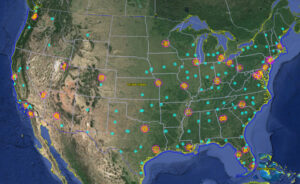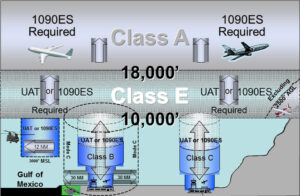
With 2019 well under way, we are in the last stretch leading up to the 2020 ADS-B Out mandate. In case you are not aware, the FAA published a final rule in May 2010 requiring all aircraft flying within certain designated airspace (largely the same airspace that requires a Mode C transponder) to be equipped with ADS-B Out by January 1, 2020. The mandate does not mean that aircraft without ADS-B will be grounded after January 1, 2020. Rather, they will only be prohibited from flying in the designated airspace. Aircraft operating above 10,000 ft. MSL or near Class B or C airspace may not be able to continue normal operations without equipping.
The FAA estimates that as many as 160,000 general aviation aircraft will require ADS-B Out, and as of February 2019, only 52,039 general aviation fixed-wing aircraft have been equipped. With less than a year left to go, that is a big difference! The FAA is firm on the January 1, 2020 date and has emphasized that there will not be any extensions to the deadline. To encourage owners of general aviation aircraft to make the switch, the FAA has brought back the ADS-B rebate program and is offering $500 to owners in return for installing ADS-B Out avionics in their aircraft. The program will run until October 11, 2019, or until all remaining rebates – at posting, just under 9,800 – are claimed, whichever comes first.
Before you do anything else, make sure that your aircraft qualifies for the rebate. The program is not retroactive, so if you have already equipped your aircraft, you are not eligible. Rebates can only be claimed for single-engine, piston-powered, fixed-wing aircraft registered before January 1, 2016. Owners of multiple aircraft can only receive one rebate.
So, if you own one of the 100,000 plus aircraft that still need to be equipped and you meet the rebate program requirements, what should you do to claim your $500 rebate? The FAA has broken down the process into five easy steps.
Decide
First, you need to decide what equipment you want to purchase. One of the biggest considerations for general aviation pilots is the cost of an ADS-B unit. There are many more choices available today than there were in 2010 when the mandate was issued, and the cost of those units varies widely. You can search for an ADS-B unit that meets your specific needs with this FAA search tool and this tool by the Aircraft Owners and Pilots Association (AOPA).
After you decide which ADS-B unit you want to purchase, shop around for pricing from multiple avionics repair stations. Then, schedule your installation. Remember, you are not the only one who will be trying to get an aircraft into the shop. Lead times of three or more months are typical, and you can expect that time to increase, especially as we get closer to the end of the year. Be sure to keep this in mind as you are planning. When you are within 90 days of the installation date, you can move on to the next step.
Reserve
Go to the FAA’s website to reserve your rebate online. Check the eligibility boxes, then fill out the rebate reservation form. Make sure that your aircraft’s information matches what is found in the FAA Civil Aircraft Registry. Select the ADS-B unit you have chosen and the date it will be installed. Finally, enter your email address and submit the form. You will be given a rebate reservation code that you will need later to claim your rebate, so don’t lose it!
Install
Now all you have to do is wait until your installation date arrives. Part 23 aircraft owners can choose from any repair station or appropriately-licensed airframe and powerplant (A&P) mechanic to perform the work.
Fly and Validate

Once the installation is complete, the rebate program gives owners 60 days to fly the airplane, validate the equipment, and claim the rebate. The validation process can be done during a routine flight as long as certain criteria are met. The flight must include a minimum of 30 consecutive minutes within the airspace requiring ADS-B, with at least 10 minutes of maneuvering.
After completing a flight that meets these requirements, request a Public ADS-B Performance Report (PAPR). This is an automated tool provided by the FAA that assists owners in validating the performance of ADS-B equipment installed in aircraft. After you enter your flight information into the tool, you will receive an email of your report within 30 minutes. You will also receive a General Aviation Incentive Requirement Status (GAIRS) report that will indicate whether the installation “passed” or “failed” the requirements for the rebate. If you receive a “fail” report, that means there is an issue with the equipment settings or the installation, and further investigation will be required. If you receive a “pass” report, it will also include an incentive code. This code will be used to claim your rebate.
Claim
Finally, it is time to claim your rebate. You must claim the rebate within 60 days of the scheduled installation date. If the rebate is not claimed within the 60-day period, the application will be voided and you will need to re-apply for another reservation code. However, there is no guarantee that another rebate will be available. When you are ready to claim your rebate, use your rebate reservation, email address, and incentive code to claim your rebate here. If you have any questions or need help at any point in the process, send an email to ADSBRebateHelp@faa.gov.
Although it may be tempting to wait until the end of the year to schedule your installation, the FAA is urging owners to take action now in order to avoid backlogs. For more information, read the Jan./Feb. 2019 issue of FAA Safety Briefing.
Want to learn more? Try out the Gleim Flight Instructor Refresher Course. The first study unit covers Navigating in the 21st Century (ADS-B, automation, NEXTGEN, glass cockpits, and more) and can be accessed for free. Even though this refresher course is intended for CFIs, it is a great resource to learn about a wide array of subjects that are critical to flight safety, decision making, risk management, ethics, and professionalism.
Written by Karl Winters, Gleim Aviation Editor and Instructor

